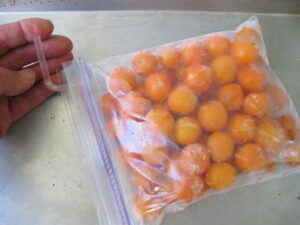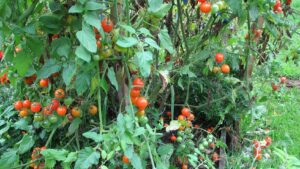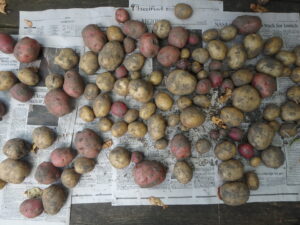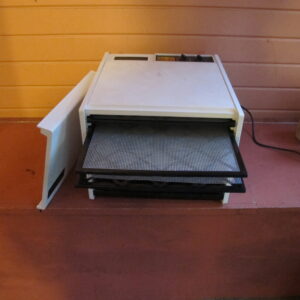Saving the Harvest
Posted on Tuesday, August 30, 2022 · Leave a Comment
Now is the time when gardeners often have too much fresh produce. People joke about locking their cars to keep neighbors from placing unneeded zucchinis in them. Our mothers and grandmothers labored over hot stoves on hot days to put up tomatoes in jars for winter, or making jam. Now there are better, easier ways to preserve the harvest. Let’s have a look.

A straw used to remove air from a bag of cherry tomatoes
I keep tomato products for later use in a number of ways. First and easiest, I freeze tomatoes whole. I put clean tomatoes in zipper bags and freeze them whole. Later, when I want tomatoes for a soup or stew, I just run hot water from the tap into a big bowl and drop in a few tomatoes. That softens them up so I can easily chop them, but it also loosens the skins. I just rub the skins with my fingers, and skin comes off. A few minutes later I chop them and they are just like canned tomatoes.
Want tomatoes for winter sandwiches? Cut them in thick slices and roast them on a sheet pan at 350 degrees until most of the moisture has gone. Then cool and place in zipper bags for storage in the freezer. When you need a tasty tomato in your sandwich, take a few slices out, and cook slightly in a toaster oven to thaw it.

Sun Gold tomatoes are very prolific and dry well for storage.
I grow many hundreds of cherry tomatoes each summer. I plant a dozen or more ‘Sun Gold’ cherry tomato plants each year, and each produces a bounty of rich, golden nuggets of flavor. What do I do with all those? I cut them in half and dry them in a food dehydrator, cut side up. When dry they will keep well in the pantry (or the freezer) in a wide-mouth quart jar. I toss a handful into every soup or stew I make.
Of course you can slice and dehydrate any kind of tomato. I have a friend who slices tomatoes, dries them until they are very crisp, and then grinds them in a food processor to make dried tomato flakes. She sprinkles the flakes into or on to a wide range of dishes. And she usually gives me a pint of them each year, which I treasure – I use it to add that mystical “umami” flavor to a dish.
A few words about food dehydrators. I have lots of experience with two good ones: NESCO American Harvest is a round dehydrator that will allow you to add many extra trays (up to 30, but with much increased drying time). NESCO dehydrators come with either top or bottom heat, so drying time is a bit uneven. The other is Excalibur, a square one with 9 trays. These blow air across the trays, and everything gets dry at once. They both have thermostats and timers that will turn them off when desired.
I use my dehydrators for drying apples and pears that are great for snacking. I cut slices about 3/8 inch thick and bag them up for snacking while they are still chewy. It looks like I will have a great grape harvest this year, and I may try making raisins. Set temperature at 125 to 135 degrees so you don’t break down vitamins.
I also use a dehydrator for drying hot peppers until they are brittle, then I grind them up in my coffee grinder to make hot pepper powder. That way I can sprinkle a little or a lot into a recipe, depending on who will be sharing dinner with me – I like food spicy.
I make tomato paste each summer, but that is more like the hard work my Grandmother did. I core the tomatoes and squeeze out excess juice and seeds, then cut them in half and drop into the Cuisinart. I run it until the tomatoes are a slurry. Then I pour the slurry into a heavy enameled cook pot. I heat it slowly, allowing the mixture to just slowly simmer (to avoid burning it).
It takes a couple of hours to fill the big kettle, and all evening for it to boil off the excess liquid. When I can literally stand up a soup spoon in the mix, I know it I thick enough. I leave the pot on the counter all night to let it cool and evaporate some more, and then in the morning I spoon the paste into ice cube trays and freeze. I put the cubes in bags or jars. It is nice to never need to remember to buy tomato paste – and to have a good use for damage tomatoes that might otherwise end up in the compost. I cut out the bad spots, and use every one.
I have never gotten excited about making jams or jellies. But if you have a dedicated freezer for storage, you can cook your raspberries or blueberries with sugar and spices, then freeze them. The canning process is lengthy and messy, so I generally avoid it. If you just want a little jam, make 3 or 4 jars and store in the fridge. It will be as tasty – and it gives you an excuse to spread some on ice cream, using it up before it get moldy.
Of course, storing food is the easiest, cheapest way to eat the harvest long after it. Winter squashes like butternut and blue Hubbard store for months in a cool, dry location. They store well for months under the bed in a guest bedroom with the radiators turned off.

Cure potatoes for a few days before storing.
When digging potatoes or pulling onions, try to do it in a dry time (not hard this summer). Lower moisture levels are better for storage. Cure them for a few days in a breezy place out of the sun. Store potatoes, carrots, celeriac and rutabagas in a place between 35 and 50 degrees with high humidity. Garlic and onions like lower humidity with cool temperatures. Sweet potatoes should never go in the fridge – they need to be stored in a warm room like the kitchen.
I try to eat something I grew every day of the year, and mostly I do that. Dried herbs, garlic and frozen foods are always there for me to use, so I do.
Henry gardens and cooks in Cornish Flat, NH. Reach him at
henry.homeyer@comcast.net. He is a regular speaker at libraries and garden clubs, and the author of 4 gardening books.
Putting Away Veggies for Winter
Posted on Tuesday, October 5, 2021 · Leave a Comment
Like any industrious squirrel, I am getting food stored and ready for winter. Even if your vegetable garden is depleted, you can buy things in bulk from your local farm stand now to save for winter.
Each type of veggie has its own requirements. Some like a cool space with high humidity. Others want it cool and dry. Then there are a few, like sweet potatoes, that require a warm space and suffer in the cold. Let’s take a look.
Storing is the easiest and cheapest way of keeping veggies for a few months. Winter squash store well in a cool dry location such as under the bed in a spare, unheated bedroom. Drafty old farmhouses have plenty of good places to store them, along with cardboard boxes of onions and garlic. I’ve stored a blue Hubbard squash (which has a very thick skin) for up to a year without any problems. But they will rot in a high humidity area.

Buy potatoes now and save for a winter meal
Potatoes, carrots, kohlrabi, rutabagas, celeriac or celery root, turnips and parsnips will store for months at 35 to 50 degrees with high humidity. You can do that in a spare fridge, preferably in a drawer that keeps humidity in it. Or put them in zipper bags and punch a few breathing holes in the bags. You can put an inch of moist sand in a bucket, and store carrots in the garage if it stays cold, but not frigid. Keep a lid on the bucket, and check from time to time. Rodents love carrots and potatoes, so you can’t store them in an open container.
I built a “cold cellar” for storing potatoes in my cold basement that often has temperatures below freezing. I made a bin of cement blocks, two layers high, and covered it with an insulated plywood lid. I weighted the lid to be sure mice could not sneak in. I put a heat mat in the bottom to use if temperatures neared freezing in the box.

A blanching pot is useful if you plan on freezing veggies 004
A full-sized freezer is a good investment. Among other things, tomatoes, corn, broccoli, beans, peppers, kale and fruit store well in a freezer. I freeze them in freezer-grade zipper bags. You can suck the excess air out of the bag with a drinking straw by closing the seal up to the straw, then pulling it out quickly and snapping shut while still sucking on the straw.
Freezing is a time-honored process for storing food. Some veggies need to be blanched before freezing to keep them tasty. Blanching is a quick immersion in boiling water before freezing. It kills the aging enzymes in your vegetables, keeping them fresh-tasting longer. If you know you will eat your frozen things within 3 months, don’t bother with it. I recommend blanching beans, beets, broccoli, Brussels sprouts, carrots, cauliflower, corn, kale, peaches, squash and Swiss chard. I freeze apples, peppers and tomatoes without blanching.
If you blanch, just do it for 60 seconds, which is often even before the water has come back to a full boil. Use lots of water in a big pot, and not too many veggies. There are special pots sold for blanching. They have an inner pot with holes that help you lift the veggies out of the water quickly.
If you blanch veggies too long they will be mushy. Drop the blanched veggies in a sink of cold water, spin dry in a salad spinner, and blot with a cloth dish towel. Then bag and freeze.

Excalibur dryer does a good job drying tomatoes, apples and hot peppers
I also dehydrate foods, notably tomatoes, hot peppers, apples and pears. You can buy a good dehydrator like the ones made by Nesco American Harvest for somewhere under $150. Or you can buy the Cadillac of dryers and get an Excalibur for $300 or more. Those use less energy and dry the food evenly without having to rotate the trays.
Dehydrating is great for hot peppers: I dry them until they are brittle, then grind them in my coffee bean grinder. That way I have a powder I can add to soups or stews a little at a time and that is well distributed. And I dry cherry tomatoes cut in half; I use them in soups and stews. They offer a bite of summer.
I also make tomato paste and freeze it in ice cube trays. I often do this with imperfect tomatoes: I cut out the bad parts and put the rest in a Cuisinart to blend them into a loose “soup” that I then cook down slowly in a big enameled cast iron pot. When I can literally stand a spoon up in the mix, it is done. Having a supply of tomato paste is essential for cooking, and I like that I don’t have to open a can when I need just a little.

I freeze tomato paste for storage in ice cube trays.
If you have an apple tree, you probably have already made some apple sauce this year. It freezes well, and is always tasty. But have you made cider? You don’t need to buy a cider press. I bring apples to my local orchard, and ask them to press and bottle the juice. Be sure to tell your orchardist that you are freezing it, and to leave an inch of space for expansion. They will charge you a fee, but it is well worth it for the satisfaction of having your own cider in winter.
Lastly, have you thought of making sauerkraut? Cabbages are easy to grow – or inexpensive to buy at your local farm stand. If you want to learn the basics just Google my name and “sauerkraut”. I wrote a full article on it in 2015 and it is available on-line along with book recommendations for in-depth learning.
One last bit of advice: don’t freeze or store any veggies or fruit that are not perfect. Freezing rotten food does not make it better! And you will not want to eat it later if you don’t want to eat it now!
Henry is an organic
gardener. He tries to eat something that came from his
garden every day of the year! Reach him at
henry.homeyer@comcast.net or PO Box 364, Cornish Flat, NH 03746.









